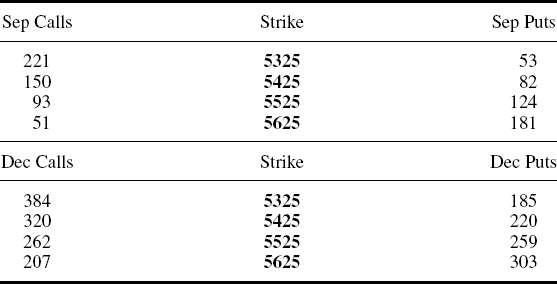26
Long Call Calendars
A long call calendar involves buying a longer-dated call against selling a shorter-dated call. For example, from the matrix of Sep and Dec FTSE 100 option prices shown in Table 26.1 (repeated from Table 25.1), buying the Sep/Dec 5625 call spread consists of two legs, buying the Dec 5625 call at 207 ticks (equivalent to £2070) per contract and simultaneously selling the Sep 5625 call at 51 ticks (equivalent to £510) per contract. The cost of the calendar is therefore 156 ticks (equivalent to £1560) per calendar spread purchased, the difference between the 207 paid for the Dec call and the 51 received for the sale of the Sep call. Why would we do such a trade?
Remember the two main reasons that option spreads have evolved; to reduce the cost of owning options and/or to reduce the risk of shorting options. In the case of a long calendar, we are looking primarily to reduce the cost of owning options. We want to buy some out-of-the-money Dec calls but want to reduce the cost of the trade by selling some similarly out-of-the-money Sep calls at the same time. Not surprisingly, by reducing cost, we are simultaneously limiting profit potential.
Table 26.1 LIFFE Sep and Dec FTSE 100 option prices as at close on 26 August 2008 (Sep FTSE 100 future = 5494, Dec FTSE 100 future = 5528)

What views on the underlying and volatility would lead us to choose such a trade? Intuitively, ...
Get Equity and Index Options Explained now with the O’Reilly learning platform.
O’Reilly members experience books, live events, courses curated by job role, and more from O’Reilly and nearly 200 top publishers.

